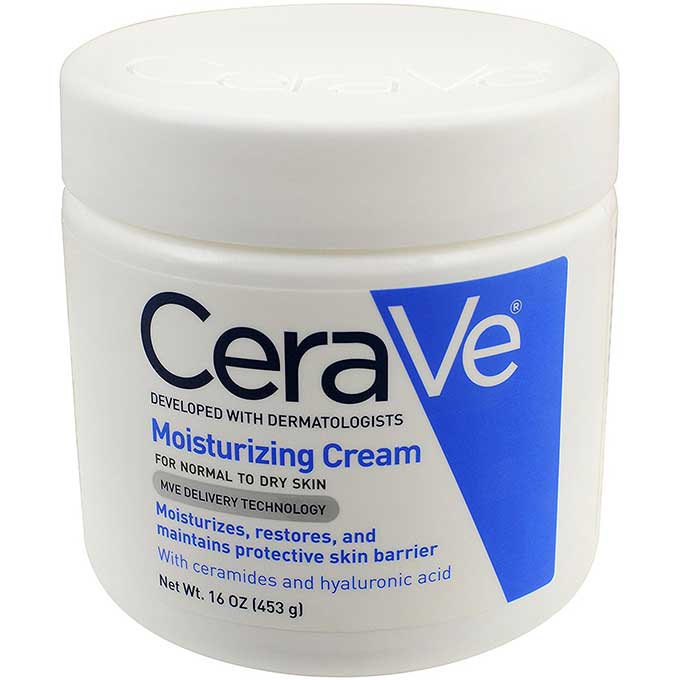CeraVe Moisturizing Cream

Moisturizing effect lasts longer than other moisturizers
Like many men, I resisted using moisturizers, until I observed that dry, cracking skin could actually get bad enough to keep me from doing manly things, like working in computers (which are notoriously dusty inside) and working on North Sea oil rigs.
A dermatologist friend recommended CeraVe Moisturizing Cream. It looks like other moisturizing creams that come in a squat canister, like Eucerin or Nivea. Like them, it is white, non-liquid, and fragrance-free. But otherwise it is quite different. Eucerin and Nivea are emulsions (mixtures) of petroleum oil or petroleum jelly, and water, plus other ingredients. They are thick, heavy and somewhat stiff. They are tried and true, and their recipes date back to 1900.
CeraVe is different. It is based mostly on glycerin “fatty alcohols,” or oils that have an hydroxide radical attached to one end (that is the technical definition of “alcohols,” and they can be volatile and light, like ethyl alcohol, or heavy like cetyl alcohol, which is an ingredient of CeraVe.) The marketing materials for CeraVe talk a lot about “ceramides,” which are waxy molecules found in cell walls, but ceramides make up a relatively small portion of CeraVe. In any case, CeraVe is a superior moisturizer.
Advantages:
– It is light and creamy. It will take peaks like whipped cream, but it is liquid enough to be dispensed with a pump. The simple squat tub is also sold with a pump dispenser attached.
– It has very little actual oil. It does have a bit of petroleum jelly, but not enough to make it greasy.
– It does a terrific job moisturizing and protecting dry skin. In my experience, it is superior to Nivea and Aveeno lotion (which contains oatmeal powder “colloid.”) There are many testimonials from people saying it “cured” their dermatitis. The usual treatment for dermatitis is an anti-inflammatory like hydrocortisone (or UV light, or other measures). But a new theory holds that dermatitis is caused by small cracks or breaks in the skin that allow irritants or toxins to enter. That might explain why a barrier cream like CeraVe helps those people.
– It does not feel sticky or leave a film. It leaves a slightly humid but supple feel on the skin.
– It isn’t particularly expensive. The large 16 oz. tub is about $16, or $1 per ounce, which is on par with similar moisturizers.
– (This is the big one.) The moisturizing effect lasts longer than other moisturizers. Something about the formula makes it resistant to being rubbed or even washed off. I notice a difference even after the next day, after I have had a hot shower. As far as I know, no other moisturizer can do that.
Disadvantages:
– It is not the absolute cheapest moisturizer out there. Pure petroleum jelly is cheaper. Of course, it is also shiny, sticky, greasy, and comes off on your clothes.
– The one time I tried it on my face, it seemed to trigger pimples. So I use something else on my face.
Shopping tips:
– Like Eucerin, Cetaphil, Aveeno, etc., there are now many different products in the CeraVe line. There are lotions, shaving creams, anti-itch creams, hand lotions, face lotions, etc. I have no experience with those.
– Cetaphil is worth distinguishing from Eucerin and Nivea. It has a more modern formula. Like CeraVe, it uses glycerine and fatty alcohols, though it doesn’t use ceramides. It might be worth experimenting with Cetaphil if for some reason you don’t want to use CeraVe. Again, I have no experience with it.
– It is possible that CeraVe is SLIGHTLY more irritating than Eucerin or Nivea. Those two are as bland as candle wax (since they are made from something that is almost candle wax.) I have had no problems with CeraVe, and I am prone to dermatitis and general skin irritation. But extremely sensitive or allergic people may conceivably have an issue.
So there you have it. CeraVe is a pleasant, odorless, easy-to-apply, non-greasy, super-effective moisturizer that provides lasting protection.
03/31/17CeraVe Moisturizing Cream, 12 oz ($12)









